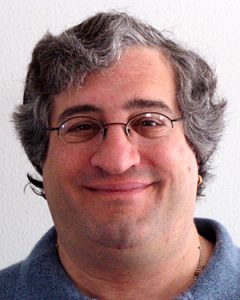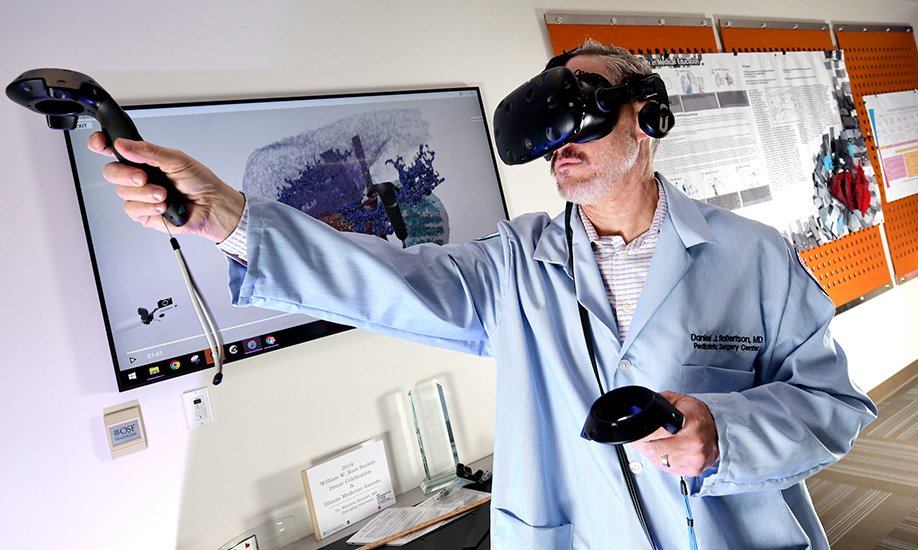Enduvo’s virtual reality technology gives doctors and patients a realistic peek inside prior to surgery
It’s not a medical tool that the fictional Dr. McCoy or Dr. Crusher would have used on Star Trek, but it’s getting there.
Virtual reality (VR) technology developed by Enduvo, a company founded by Dr. Matt Bramlet, a pediatric cardiologist, is helping doctors at OSF Saint Francis Medical Center and their patients and families get a pre-surgery, three-dimensional virtual reality look at the procedure.
Enduvo was born in 2018. Bramlet runs the congenital cardiac MRI program at the Children’s Hospital of Illinois and the University of Illinois College of Medicine at Peoria.
The 3D work is done by OSF’s Advanced Imaging and Modeling Lab, made up of a team of OSF Jump Simulation engineers and medical professionals who are proficient in Enduvo’s technology and have developed new methods for automating the process.
OSF was one of Enduvo’s first customers five years ago.
“As the product has continued to evolve and improve, we’re been right there alongside them on the journey,” said Dr. Kip McCoy, vice president of the OSF Innovation Studio.
Dr. Daniel Robertson, a pediatric oncologist at OSF, is a huge fan. As he explains the technology, two-dimensional images from a CT scan or MRI of a surgical area are converted into virtual reality. Wearing 3D goggles, he can actually manipulate the area he will operate on and become immersed in it.
“Normally, when you’re going from 2D to 3D, your brain has to translate that information into 3D,” he said. “Research shows that surgeons vary in their ability to do that. But this technology does it for you.
“When I go do an operation after seeing it in 3D, it feels like I’ve already seen the anatomy of the surgical area. I know what the relationship of structures is going to be, what to look out for, and what’s going to be in a particular location. Virtual reality gives me a lot of insights.”
If it’s difficult for surgeons to translate 2D to 3D images pre-surgery, imagine what it’s like for patients and their families.
“They’ve never done that,” Robertson said. “So I make a five-minute 3D video and talk through the surgery with them.
“I tell them this isn’t an educational video. I tell this patient, ‘This is your tumor.’ That is what the tumor looks like in your body. This is your anatomy. This is what we’re going to do. This is how we’re going to approach it and this is what we have to watch out for.
“This 3D tool is valuable for both of us.”
Robertson has done about 35 surgeries using virtual reality. He said he’s never backed off on a surgery after using virtual reality, although his concern about doing a surgery on a patient was confirmed after seeing the virtual reality images.
“The more complex a case is, the more valuable this technology is,” Robertson said, emphasizing that it’s a team effort. “I get the end product, but there’s a lot of things that happen behind the scenes.”
‘I could see the relationship of the tumor to the surrounding critical structures … My confidence grew’— Dr. Daniel J. Robertson
Robertson said he’d like to see the technology universally adopted. He’s working toward that goal, which includes getting insurance companies to cover it.
“Ultimately, it’s not just about what you’re doing academically. Is it helpful for patients? It clearly is,” he said.
It was in early 2021 that Robertson began to use virtual reality for pre-surgery planning for his pediatric oncology cases. He handles thoracic, abdominal and pelvic tumors in children.
“When I tried it for the first time, it was an eye-opening experience,” he said. “Anatomic relationships were much closer. I could see the relationship of the tumor to the surrounding critical structures in three dimensions. And overall, my confidence grew when I went into the operating room.”
Robertson conducted a study at the time, asking surgeons to view cases in 2D and 3D. Surgeons’ confidence level increased 62.5% after they saw their cases in 3D, and their operative plans changed 8.3% of the time, he said.
“There was no instance where a doctor’s confidence level decreased after the virtual reality review,” he said. “My adult surgical oncology colleagues used the technology and found their operative plans changed even more of the time. Many said it felt like they had been there (inside the body and surgical area) after viewing the virtual reality models.”
Enduvo’s VR technology also is used in the training of medical students and other health professionals.
In 2020, a team from the Illinois College of Medicine at Peoria and OSF HealthCare’s Jump Trading Simulation and Education Center investigated the use of VR as a training tool to help medical students diagnose critically ill patients. Twenty volunteer UICOMP students acted as patients. There were two cases: an adult with an unstable heart rhythm and a child with difficulty breathing.
The actors were video recorded as patients presented with symptoms of distress, and the recordings were embedded into a VR video. Medical students proceeded through the cases at their own pace while being provided immediate feedback on their questions.
The students rated virtual reality equal to or better than a traditional lecture.
Researchers were surprised to find that not one checked a phone to answer a text while wearing the VR headset.
Their confidence soared. Before watching the recordings, only 5% said they were completely confident in their ability to provide the right treatment. Afterwards, 45% said they trusted themselves fully, and 55% said their self-assurance had increased. No students rated themselves “not at all confident.”
“Truthfully, it’s a very different culture from when I started teaching many years ago,” said Dr. Teresa Morrel Riech, medical director in the Pediatric Emergency Department at OSF, who was on the research team. “In the digital age, this is how we can keep learner attention most effectively. Medical students are not going to listen to me for 30 minutes and certainly not for an hour, but when you flip the classroom and they have control over it, it’s a very different outcome.”
The 3D technology was particularly helpful at OSF during the COVID pandemic, when students couldn’t see patients.
“We were able to create scenario-based education for the students,” said Alexa Waltz, program manager for the AIM Lab. “We would do mild, moderate and severe presentations of conditions and we got really good feedback from students, who were able to learn in a way they weren’t accustomed to.
“They felt truly immersed in the environment.”





